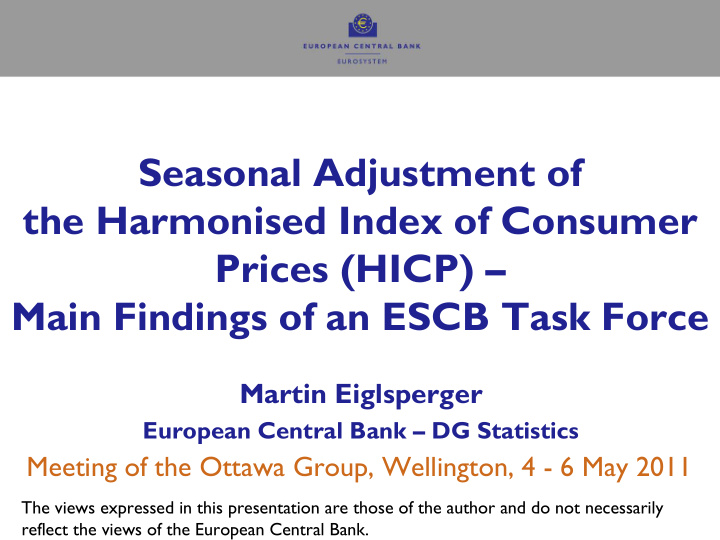



Seasonal Adjustment of the Harmonised Index of Consumer Prices (HICP) – Main Findings of an ESCB Task Force Martin Eiglsperger European Central Bank – DG Statistics Meeting of the Ottawa Group, Wellington, 4 - 6 May 2011 The views expressed in this presentation are those of the author and do not necessarily reflect the views of the European Central Bank.
2 Consumer Price Index Manual (ILO et al.) • Chapter 13: “Publication, Dissemination and User Relations” • “Seasonal adjustment and smoothing of the index” • Chapter 22: “The Treatment of Seasonal Products” • Para. 22.7: “… rolling year indices can be regarded as seasonally adjusted price indices …” • Para. 22.61: “more sophisticated methods” of seasonal adjustment, but rolling year indices as targets Central Banks’ views on seasonal adjustment of consumer price indices might be somewhat different
3 Current practices in the EU EU statistical institutes: headline figure year-on-year • rate of change, no seasonal adjustment of HICPs • Seasonal adjustment of (non-harmonised) consumer price indices: INSEE (France), Office for National Statistics (UK) and Deutsche Bundesbank (Germany), some other national central banks (in particular Banca d’Italia) for internal purposes no particular role in the EU, different to the US and Canada • Seasonally adjusted HICPs for the euro area: ECB published on the website, in the Monthly Bulletin …
4 ECB inflation analysis and forecasting Key breakdown: “main components” • Unprocessed food (meat, fish, fruit and vegetables) • Processed food (incl. alcohol and tobacco) • Industrial goods (excl. energy) • Services • Energy Forecasted seasonal factors Seasonally adjusted month-on-month rates of change Base effects in year-on-year rates of change
5 Seasonality in HICP main components mainly present in • HICPs for unprocessed food, primarily due to seasonality in prices for fresh fruit and vegetables • HICPs for industrial goods, primarily due to sales prices for clothing and footwear but also in • HICPs for services which may be also affected by calendar effects (dating of Easter) via its holiday-related price indices while weak and/ or “erratic” seasonality is found in • HICPs for processed food (alcohol and tobacco!) • HICP for energy
6 Seasonal adjustment of euro area HICP Current ECB practice • Seasonal adjustment of HICP main components except energy • No seasonal adjustment of HICP for energy, since identifiable seasonality is currently not present • Seasonally adjusted total HICP obtained by aggregating seasonally adjusted main component indices + unadjusted energy price index • Normal HICP weights are used
7 Euro area HICP Month-on-month percentage changes unadjusted seasonally adjusted 1.5 1.0 0.5 0.0 -0.5 -1.0 1996 1997 1998 1999 2000 2001 2002 2003 2004 2005 2006 2007 2008 2009 2010
8 Task Force: members and mandate “Task Force on Seasonal Adjustment of National HICPs” • Members: eight EU national central banks, two statistical institutes + Eurostat as observer, chair and secretariat: ECB • Mandate: • Review and specification of existing guidelines • Treatment of seasonal breaks • Treatment of changes in VAT and excise duties • Calendar effects, e.g. in price indices for package holidays • Aggregation of seasonally adjusted component indices
9 Recommendations and guidelines
10 Seasonal breaks Euro area HICP – industrial goods: index levels unadjusted seasonally adjusted (whole series) seasonally adjusted (split factors Dec.2000/Jan.2001) 100.0 99.0 98.0 97.0 96.0 95.0 94.0 1999 2000 2001 2002
11 Taxes and excise duties Euro area HICP – Processed food excl. alcohol and tobacco: month-on-month percentage changes unadjusted seasonally adjusted 2.0 1.5 1.0 0.5 0.0 -0.5 2000 2001 2002 2003 2004 2005 2006 2007 2008 2009 2010
12 Calendar effects Euro area HICP – Services: month-on-month percentage changes (Easter in March: 2002, 2005 and 2008) unadjusted seasonally adjusted 1.5 1.0 0.5 0.0 -0.5 -1.0 2000 2001 2002 2003 2004 2005 2006 2007 2008 2009 2010
13 Aggregation (1): Issue Which weights to use for aggregating seasonally adjusted component indices? • HICP: chain-linked index, weights at prices of previous year’s December • Trend levels of seasonally adjusted HICP and unadjusted HICP should not differ systematically • Current approaches: Bureau of Labor Statistics (USA), Office for National Statistics (UK) und ECB Use of “normal” weights
14 Aggr. (2): HICP index number concept • HCPI: Chain-linked Laspeyres-type (“Lowe”) index • Link period: December • Weights refer to a certain weight reference period, expressed in December prices “Price-updating” of expenditure shares • EU national statistical institutes conduct either annually updating weights (quantities) or every five years (or so)
15 Aggregation (3): Example – components Example by J. Walschots (Eurostat): Unadjusted indices, Price-updating of weights to December prices Component 1 Component 2 Component 3 Total 300 250 200 150 100 50 0 1 2 3 4 5 6 7 8 9 10 11 12 13 14 15 16
16 Aggregation (4): Example – first approach Example by J. Walschots (Eurostat): Seasonally adjusted indices, price-updating with unadjusted components Component 1 Component 2 Component 3 Total 300 250 200 150 100 50 0 1 2 3 4 5 6 7 8 9 10 11 12 13 14 15 16
17 Aggregation (5): Example – second appr. Example by J. Walschots (Eurostat): Seasonally adjusted indices, price-updating with seasonally adj. components Component 1 Component 2 Component 3 Total 300 250 200 150 100 50 0 1 2 3 4 5 6 7 8 9 10 11 12 13 14 15 16
18 Aggregation (6): Example – Trend level Annual average in the year 16 • Unadjusted total index: 160.1358 • Indirectly seasonally adjusted total index, price- updating of expenditure shares with unadjusted component indices: 140.6291 • Indirectly seasonally adjusted total index, price- updating of expenditure shares with seasonally adjusted component indices: 160.1358
Recommend
More recommend